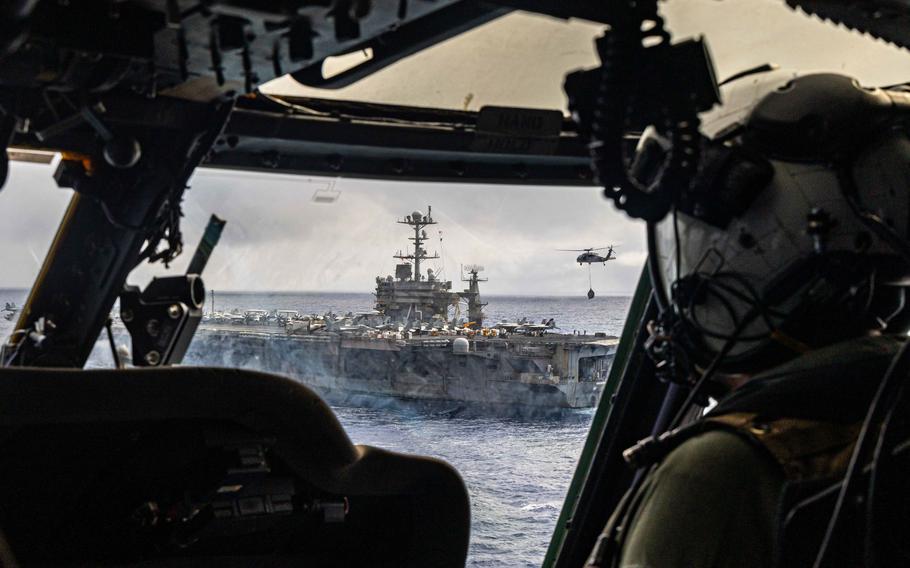
An MH-60S Sea Hawk helicopter conducts a vertical-replenishment with the Nimitz-class aircraft carrier USS Harry S. Truman in the Atlantic Ocean on May 25, 2025. (U.S. Navy)
WASHINGTON — The USS Harry S. Truman and its strike group will return to the U.S. over the next four days following a deployment battling Houthi drones and missiles in the Red Sea, the Navy announced Thursday.
Components of the strike group will return to their homeports Thursday through Sunday, the 2nd Fleet said in a statement. The strike group includes the aircraft carrier Truman, as well as cruiser USS Gettysburg and destroyer USS Stout, both homeported at Naval Station Norfolk, Va., and destroyer USS Jason Dunham, homeported at Naval Station Mayport, Fla. A nine-squadron air wing with about 80 aircraft deployed aboard the ships.
The homecomings will conclude a more than eight-month deployment that began Sept. 23, 2024, when the Truman left its homeport in Norfolk, Va., for a routine deployment to the 6th Fleet area of operations.
The aircraft carrier and its strike group then traveled to the Middle East in December where the ships spent more than five months defending merchant mariners and military vessels from Houthi drones and missiles in the Red Sea and the Gulf of Aden. The strike group also carried out strikes against the Iran-backed militants in Yemen, which was part of President Donald Trump’s order to conduct daily strikes on the militants until they stopped targeting merchant ships.
The strikes were conducted for about seven weeks, from March 15 to May 8. The Pentagon said U.S. forces struck more than 1,000 Houthi targets in late March. Defense officials have not provided additional strike counts.
Recently, Adm. James Kilby, acting chief of naval operations, touted the Truman’s participation in a strike against Islamic State targets in northeast Somalia in coordination with U.S. Africa Command. The strike, Kilby said, was the largest airstrike launched from an aircraft carrier, in which about 125,000 pounds of munitions were dropped.
But the Truman’s deployment was marred with incidents, including the loss of three fighter jets that cost about $67 million each. The carrier also collided with a cargo ship and the ship’s commanding officer was fired.
One of the fighter jets lost during the deployment was shot down in December during a friendly fire incident. A second jet, being moved on the Truman by a towing tractor, fell overboard in late April as the carrier made a “hard turn.” About one week later, in early May, a third fighter jet crashed into the Red Sea after the aircraft failed to land on the carrier. In each instance, one or two sailors involved suffered minor injuries.
The collision happened in February with a merchant ship while operating near Egypt’s Port Said. The carrier sustained damage to a line handling space, its fantail and a platform above a storage space. Repairs and a thorough evaluation of Truman’s hull, which was penetrated well above the waterline on its right back end, required a week stay at Souda Bay.
The Truman’s commanding officer, Capt. Dave Snowden, was fired a little more than one week after the collision, with the Navy citing a loss of confidence in Snowden’s ability to command.
Capt. Chris Hill, commanding officer of the aircraft carrier USS Dwight D. Eisenhower, was named the Truman’s interim commander. Hill has served as the Truman’s interim commander since the collision.